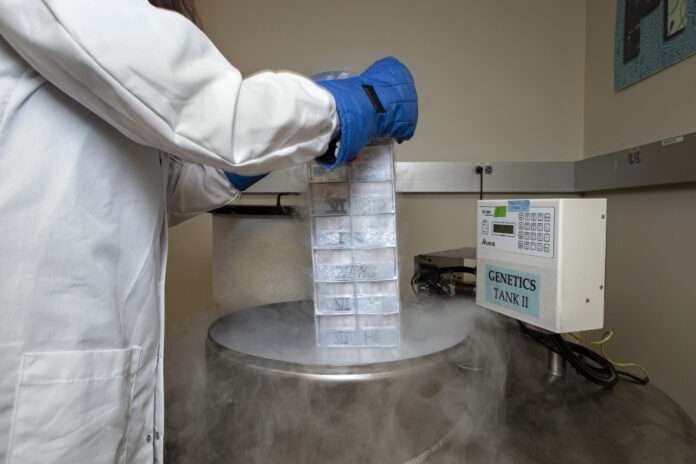San Diego Zoo Wildlife Alliance has been recognized for its expertise in wildlife biobanking, and has partnered with the Species Survival Commission (SSC) of the world’s largest conservation organization—the International Union for Conservation of Nature (IUCN)—to form the new Center for Species Survival: Biodiversity Banking. The new center is the first ever to have a strategy focus rather than a taxonomic one.
“We are honored to partner with the IUCN Species Survival Commission to bring about awareness and further build upon biodiversity banking as a tool to conserve species,” said Nadine Lamberski, DVM, Dipl. ACZM, Dipl. ECZM (ZHM), chief conservation and wildlife health officer,
San Diego Zoo Wildlife Alliance. “Biodiversity banks like ours are becoming essential to saving species in the face of increasing biodiversity loss. And as novel technologies emerge, biobanks lay the foundation for trailblazing conservation solutions by bridging today’s samples to tomorrow’s scientific potential.”
Biobanking describes the intentional and indefinite preservation of living cells, tissues, gametes (eggs and sperm), seeds and other biomaterials. Biobanking both preserves unrecoverable genetic diversity in wildlife species and expands capacity for genetic rescue strategies, both today and into the future.
Centers for Species Survival are partnerships between leading conservation organizations and the IUCN SSC, which includes conservationists from around the world. Centers are often hosted by zoological and botanical conservation organizations that are engaged in work with key species or specific focus areas. With this partnership, San Diego Zoo Wildlife Alliance will collaborate with the IUCN SSC global network of partners to develop and provide best practices guidance, maximize genetic diversity preservation, and train and advise partners in the establishment and expansion of biobanks.
“This new Center for Species Survival: Biodiversity Banking with San Diego Zoo Wildlife Alliance is an incredible opportunity to build capacity and catalyze best practice in an important and growing aspect of global efforts to safeguard biodiversity,”said Kira Mileham, Ph.D., IUCN SSC director of strategic partnerships. “Members of San Diego Zoo Wildlife Alliance co-chair the IUCN SSC Animal Biobanking for Conservation Specialist Group, actively engaged in advancing capacity-building initiatives and working with partners around the world to facilitate the equitable sharing of benefits derived from biodiversity resources.”
San Diego Zoo Wildlife Alliance’s Wildlife Biodiversity Bank is an invaluable scientific resource for conserving species, and safeguards living and nonliving materials in six distinct collections: Frozen Zoo®: gametes, embryos and cells; Tissue and DNA Bank: tissues, DNA, blood and cells; Native Plant Gene Bank: seeds, plant cuttings and herbarium vouchers (pressed and dried specimens); Pathology Archive: tissues, microbes, DNA and RNA; Clinical Repository: bodily fluids and blood components (plasma and serum); and Wildlife Artifacts: skeletal replicas and items naturally shed or lost (such as feathers and leaves.) Together, these collections can aid in advancing wildlife health, care, education and conservation.
The Frozen Zoo® is the foundational and most recognizable component of the Wildlife Biodiversity Bank. Established nearly 50 years ago, the Frozen Zoo is the largest and most diverse collection of its kind in the world, with more than 10,900 living cell cultures, gametes and embryos representing nearly 1,250 species and subspecies. Cell lines are grown from tissue collected from a variety of mammals, birds, reptiles, amphibians and fish. From those tissues, living fibroblast cells are grown, and then stored in liquid nitrogen freezers at a temperature of -320 degrees Fahrenheit.
The Wildlife Biodiversity Bank receives and shares samples and data with hundreds of scientific collaborators worldwide. Recently, skin cells stored in the Frozen Zoo were provided to collaborators to produce genetically unrepresented clones of two endangered species: a black-footed ferret and two Przewalski’s horses. With applications including assisted reproduction, stem cell technology, evolutionary biology and wildlife medicine, the Frozen Zoo has the potential to reverse losses of genetic diversity and contribute to population sustainability.
“Samples from the Wildlife Biodiversity Bank have already had a significant impact on diverse fields of biology,” said Oliver Ryder, Ph.D., director of conservation genetics, San Diego Zoo Wildlife Alliance, and co-chair of the SSC Animal Biobanking for Conservation Specialist Group. “As genomic studies advance, genome sequence information is utilized in all aspects of biological inquiry, and is evermore applicable to characterizing and conserving biodiversity.”
As a Center for Species Survival, San Diego Zoo Wildlife Alliance joins a distinguished network of conservation organizations worldwide that share a common goal of preventing species extinction and ensuring a sustainable future for the planet. For more information on San Diego Zoo Wildlife Alliance and the Wildlife Biodiversity Bank, visit sdzwa.org. For more information on the International Union for Conservation of Nature Species Survival Commission, visit iucn.org.






